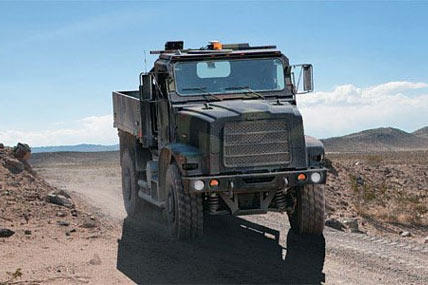The Army wants to retrofit a portion of its tactical wheeled vehicle fleet with robotic brains so that unmanned trucks, not troops, are put in harm's way during resupply and route clearance missions.
Removing drivers from truck cabs also frees up soldiers to perform more complex tasks at a time when declining budgets are putting a premium on manpower.
The Marine Corps has been testing autonomous resupply and casualty evacuation by ground and by air at its Warfighting Laboratory and in field tests at various installations. Unmanned helicopters that fly pre-planned routes to forward operating bases in Afghanistan have already proven their worth in combat.
William Moore, deputy to the commanding general of the Army Sustainment Center of Excellence, recently described "autonomous ground mobility" as the service's number-one desired next-generation truck technology.
"Taking drivers out of trucks and repurposing them even within the cab, there is a lot of potential there," he said at the National Defense Industrial Association's annual Tactical Wheeled Vehicles conference. "That is probably our number-one low-hanging fruit."
Officials at the center, based at Fort Lee, Virginia, are working with counterparts at Research, Development and Engineering Command to help technologies bridge the valley of death between the lab and the battlefield, Moore said.
"We have briefed Chief [of Staff Gen. Raymond] Odiemo and leadership on the potential to get them through to the appropriate technology readiness level to where we can actually look at options to take it to ... procurement and fielding," he said. "We are trying to automate tasks so that we can repurpose [soldiers] to other functions."
Outfitting trucks that haul water and food with sensor packages, allowing them to navigate to and from forward battlefield positions, has the most immediate potential to remove troops from convoys. The basic technological capability has been proven, though some functions like sense-and-avoid systems are not yet up to snuff, Moore said.
A joint technology concept demonstration of autonomous truck convoys involving both the Army and Marine Corps is ongoing. The system will undergo a military utility assessment this summer, Moore said.
Autonomous robots that remove humans from immediate control of vehicles and aircraft are not yet sophisticated enough for complex tasks like navigating cluttered terrain or choosing friend from foe. The prospect of arming robots has been met with stiff resistance if a human is not included in the decision-making loop. Moore said those issues would not likely interfere with route clearance, combat resupply and similar transportation missions.
"Are these technologies realizable in the near future?" Moore asked. "There are some folks who say we'll never be able to get through the legal and policy constraints of autonomous ground resupply, but yet I see cars parking themselves in the parking lot. It seems like we're getting there a lot faster than some of us can even realize"
Oshkosh Defense already has outfitted the Marine Corps medium tactical vehicle with the TerraMax autonomy retrofit kit that allows a convoy of several trucks to be driven by a single person. The cargo unmanned ground vehicle project began in 2010 to find out how Marines might use driverless trucks to reduce vulnerable resupply convoys and streamline battlefield logistics.
The TerraMax kit has now been installed aboard Oshkosh's off road version of the mine-resistant, ambush protected vehicle, the M-ATV.The unmanned armored truck would push roadside bombdetecting equipment ahead of several unmanned UGVs, followed by a manned truck overseeing the route clearance operation.
Oshkosh and the National Robotics Engineering Center have partnered with the Office of Naval Research and the Naval Surface Warfare Center to integrate counter-IED technologies onto the cargo-UGV and M-ATV.
TerraMax can be outfitted with ground-penetrating radar and mine rollers to find and destroy IEDs without exposing manned vehicles to blasts. The system's operator control unit also can provide over-the-horizon situational awareness, according to company information.
"Government evaluations revealed that the state-of-the-art autonomous capability offered practical utility in a variety of operational situations," according to a statement from Oshkosh. "Live force experiments in which combat-veteran Marines were trained to operate the UGVs in concert with manned vehicles furthered the development of concepts of operation for robotic systems in combat environments."
The Army has an interest in that and similar technologies in its effort to "reduce the number of personnel on the battlefield without sacrificing capability to achieve reductions in force structure," Moore said. On route-clearance missions, fewer drivers means those personnel can be repurposed to perform other tasks, he said.
"The clearance of threats like IEDs, mines and unexploded munitions pose challenges that global military forces have faced since World War II and are expected to continue long after Afghanistan," said John Urias, president of Oshkosh Defense. "Our TerraMax UGV technology can bring autonomous capabilities to existing manned vehicle platforms, like the M-ATV, to remove troops from targeted routes and provide greater standoff distance from explosive threats."
Navy engineers have developed a similar sensor package that can turn any helicopter with a digital flight control system into an autonomous cargo delivery robot.
The system, called the autonomous aerial cargo/utility system, or AACUS, was twice tested successfully in March at Quantico Marine Corps Base in Virginia.
Using electro-optical, forward-looking infrared and light-detection and ranging sensors, the AACUS allows the aircraft flight computers to continuously scan the surrounding environment, Brig. Gen. Kevin Killea, commander of the Marine Corps Warfighting Lab, said.
The system weighs about 100 pounds and is designed to be platform agnostic. It is envisioned as an affordable retrofit kit that can be added to any helicopter in the Marine Corps inventory. Killea said the goal was to develop a kit that cost less than $25,000 per unit.
AACUS was tested aboard Lockheed Martin's K-MAX and Boeing's unmanned Little Bird helicopter.
Recognizing K-MAX's success in autonomously delivering millions of pounds of supplies to Marines at forward operating bases in Afghanistan, Sikorsky in May announced development of an unmanned version of its Black Hawk utility helicopter, which will reuse retired UH-60A airframes.


























